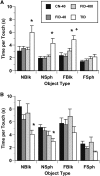Behavior and monoamine deficits in prenatal and perinatal iron deficiency are not corrected by early postnatal moderate-iron or high-iron diets in rats
- PMID: 22990465
- PMCID: PMC3498975
- DOI: 10.3945/jn.112.162198
Behavior and monoamine deficits in prenatal and perinatal iron deficiency are not corrected by early postnatal moderate-iron or high-iron diets in rats
Abstract
Developmental iron deficiency anemia (IDA) causes brain and behavioral deficits in rodent models, which cannot be reversed when treated at periods equivalent to later infancy in humans. This study sought to determine whether earlier iron treatment can normalize deficits of IDA in rats and what iron dose is optimal. The offspring of dams with IDA during gestation were cross-fostered at postnatal d (P) 8 to dams receiving diets with 1 of 3 iron concentrations until weaning (P21): 0.003-0.01 g/kg [totally iron deficient (TID)]; 0.04 g/kg [formerly iron deficient (FID-40)]; or 0.4 g/kg (FID-400). Always iron-sufficient control dams (CN-40) received a 0.04-g/kg iron diet. At P21, TID pups received a 0.01 g iron/kg diet; all others received a 0.04 g iron/kg diet. Hematocrit and brain iron and monoamine concentrations were assessed at P21 and P100. Pup growth, development, activity, object recognition, hesitancy, and watermaze performance were evaluated. Regional brain iron was restored by iron treatment. Regional monoamine and metabolite concentrations were elevated in FID-40 rats and reduced in FID-400 and TID rats compared with CN-40 rats. FID-40 offspring had motor delays similar to TID during lactation and FID-400 rats had elevated thigmotaxis similar to TID rats at P25 and P100 in the spatial watermaze. In conclusion, iron treatment at P8 in rats did not normalize all monoamine or behavioral measures after early IDA. Moderate iron treatment improved adult behavior, but higher iron treatment caused brain and behavioral patterns similar to TID in the short and long term.
Conflict of interest statement
Author disclosures: E. L. Unger, A. R. Hurst, M. K. Georgieff, T. Schallert, R. Rao, J. R. Connor, N. Kaciroti, B. Lozoff, and B. Felt, no conflicts of interest.
Figures




Similar articles
-
Brain iron and behavior of rats are not normalized by treatment of iron deficiency anemia during early development.J Nutr. 1996 Mar;126(3):693-701. doi: 10.1093/jn/126.3.693. J Nutr. 1996. PMID: 8598555
-
Persistent neurochemical and behavioral abnormalities in adulthood despite early iron supplementation for perinatal iron deficiency anemia in rats.Behav Brain Res. 2006 Aug 10;171(2):261-70. doi: 10.1016/j.bbr.2006.04.001. Epub 2006 May 19. Behav Brain Res. 2006. PMID: 16713640 Free PMC article.
-
Early postnatal iron repletion overcomes lasting effects of gestational iron deficiency in rats.J Nutr. 2007 May;137(5):1176-82. doi: 10.1093/jn/137.5.1176. J Nutr. 2007. PMID: 17449578
-
Prepartum anaemia: prevention and treatment.Ann Hematol. 2008 Dec;87(12):949-59. doi: 10.1007/s00277-008-0518-4. Epub 2008 Jul 19. Ann Hematol. 2008. PMID: 18641987 Review.
-
Long-term brain and behavioral consequences of early iron deficiency.Nutr Rev. 2011 Nov;69 Suppl 1(Suppl 1):S43-8. doi: 10.1111/j.1753-4887.2011.00432.x. Nutr Rev. 2011. PMID: 22043882 Free PMC article. Review.
Cited by
-
Maternal Iron Deficiency Programs Offspring Cognition and Its Relationship with Gastrointestinal Microbiota and Metabolites.Int J Environ Res Public Health. 2020 Aug 20;17(17):6070. doi: 10.3390/ijerph17176070. Int J Environ Res Public Health. 2020. PMID: 32825437 Free PMC article.
-
The Benefits and Risks of Iron Supplementation in Pregnancy and Childhood.Annu Rev Nutr. 2019 Aug 21;39:121-146. doi: 10.1146/annurev-nutr-082018-124213. Epub 2019 May 15. Annu Rev Nutr. 2019. PMID: 31091416 Free PMC article.
-
Intranasal insulin treatment partially corrects the altered gene expression profile in the hippocampus of developing rats with perinatal iron deficiency.Am J Physiol Regul Integr Comp Physiol. 2023 Oct 1;325(4):R423-R432. doi: 10.1152/ajpregu.00311.2022. Epub 2023 Aug 21. Am J Physiol Regul Integr Comp Physiol. 2023. PMID: 37602386 Free PMC article.
-
Biomarkers of Nutrition for Development (BOND)-Iron Review.J Nutr. 2018 Jun 1;148(suppl_1):1001S-1067S. doi: 10.1093/jn/nxx036. J Nutr. 2018. PMID: 29878148 Free PMC article. Review.
-
Sleep patterns in male juvenile monkeys are influenced by gestational iron deprivation and monoamine oxidase A genotype.Br J Nutr. 2014 Nov 14;112(9):1478-83. doi: 10.1017/S0007114514002451. Br J Nutr. 2014. PMID: 25351859 Free PMC article.
References
-
- Beard J, Erikson KM, Jones BC. Neonatal iron deficiency results in irreversible changes in dopamine function in rats. J Nutr. 2003;133:1174–9 - PubMed
-
- Unger EL, Paul T, Murray-Kolb LE, Felt B, Jones BC, Beard JL. Early iron deficiency alters sensorimotor development and brain monoamines in rats. J Nutr. 2007;137:118–24 - PubMed
-
- Jorgenson LA, Sun M, O'Connor M, Georgieff MK. Fetal iron deficiency disrupts the maturation of synaptic function and efficacy in area CA1 of the developing rat hippocampus. Hippocampus. 2005;15:1094–102 - PubMed
Publication types
MeSH terms
Substances
Grants and funding
LinkOut - more resources
Full Text Sources
Medical

